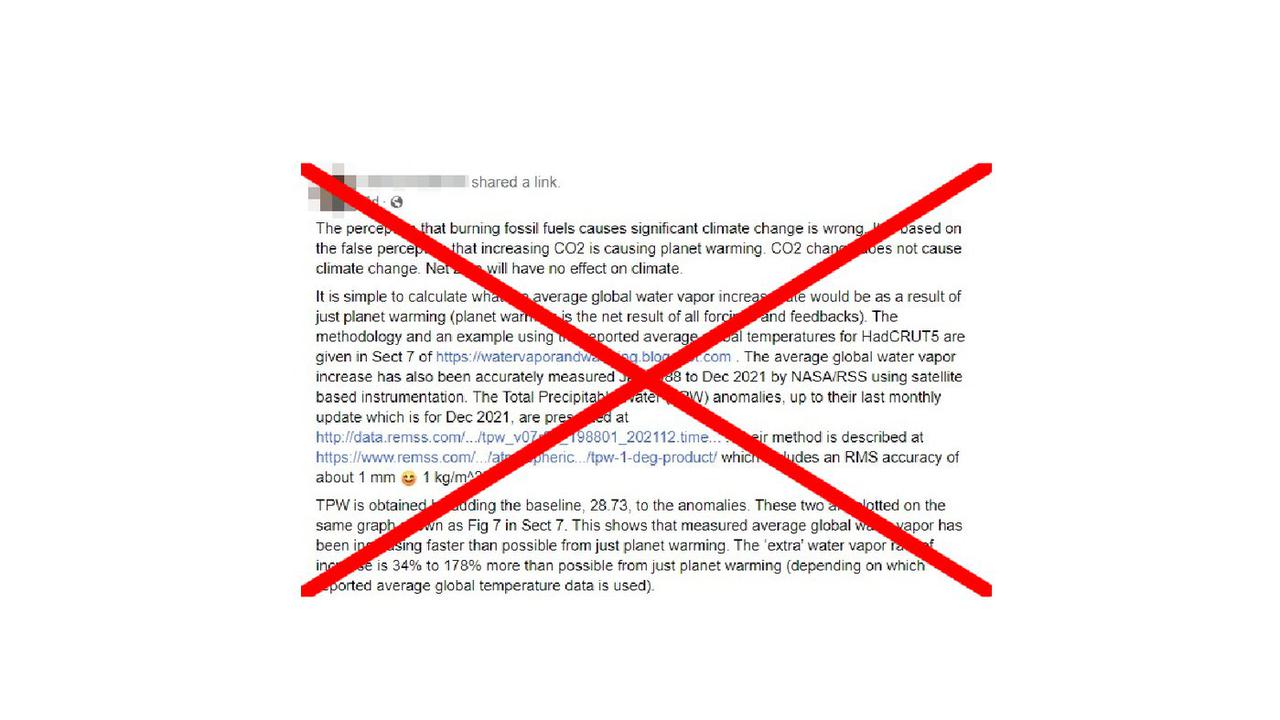WHAT WAS CLAIMED
An increase in water vapour is solely responsible for the rise in global temperatures since the end of the 19th century
OUR VERDICT
False. CO2 and other greenhouse gases drive global warming. Water vapour amplifies warming initiated by these gases through a positive feedback loop.
A Facebook user rejects the idea that an increase in carbon dioxide caused by burning fossil fuels is contributing to global warming. Instead, he claims water vapour is the sole cause of rising global temperatures since the end of the 19th century.
This is not true. While water vapour does contribute to global warming, it is not the only factor causing temperatures to rise. Water vapour reacts to temperature changes and amplifies the warming effect of CO2 and other greenhouse gases.
The post (archived here) was shared on November 15, 2022 to a climate change discussion group.
"The perception that burning fossil fuels causes significant climate change is wrong. It is based on the false perception that increasing CO2 is causing planet warming. CO2 change does not cause climate change," it begins.
Further down the post, the Facebook user writes: "Average global temperature increase of [global warming] has been contributed to by measured [water vapour] increase, not CO2 increase… All of average global temperature increase attributable to humanity since before 1895 can be accounted for by [water vapour] increase alone."
Other versions of the claim have been shared here and here. Similar claims have also been debunked by other outlets, such as here and here.

Water vapour — the most abundant greenhouse gas — is formed when water from the ocean or on land evaporates and rises up into the atmosphere. Water vapour molecules absorb infrared energy and radiate it out in all directions, sending some heat back to Earth, thereby contributing to the greenhouse effect.
According to the Intergovernmental Panel on Climate Change (IPCC), the amount of water vapour in the troposphere has increased by approximately 3.5 per cent in the past 40 years.
Andrew Dessler, a professor of climate science and director of the Texas Center for Climate Studies at Texas A&M University said water vapour itself is responsible for about half of the greenhouse effect.
"Water also condenses into clouds, and clouds also trap heat and are responsible for another quarter of the greenhouse effect. So, combined, three quarters of the greenhouse effect comes from water."
Carbon dioxide, methane, nitrous oxide and several other gases contribute to the greenhouse effect in smaller amounts.
However, this does not mean global temperature rise can be solely attributed to an increase in water vapour.
"Water vapour is indeed the primary greenhouse gas in our atmosphere. However, that fact by itself is misleading because water vapour in our atmosphere is set by the Earth's surface temperature," Prof Dessler told AAP FactCheck in an email.
"Thus, adding carbon dioxide to the atmosphere gives us some initial warming, which then increases the amount of water vapour in the atmosphere, which gives us additional warming."
Warmer temperatures lead to more evaporation, which in turn increases the amount of water vapour in the air. Since water vapour is a greenhouse gas, this means more molecules trap heat and further contribute to the warming effect.
"This vicious cycle is what's known as the water vapour feedback. In this way, water vapour is amplifying the warming we get from carbon dioxide alone," Prof Dessler confirmed.
David Noone, a professor of climate physics and director of the Auckland University Research Centre for Climate, Biodiversity and Society, noted that there is a distinction between the greenhouse effect and global warming.
Rising temperatures and global warming occur due to an enhancement of the greenhouse effect.

"The cause of the enhancement is the addition of CO2 (and other gases) resulting from human industrial activities (including deforestation)," Prof Noone said in an email.
"The change [increase] in the greenhouse effect, which is seen as global warming, is caused [by] CO2 and methane amounts."
Brian Soden, a professor of atmospheric science at the University of Miami, explained that while water vapour does not initiate changes in climate, the positive feedback loop amplifies any changes.
"When water vapour evaporates into the atmosphere, it only resides for a short amount of time — about 10 days. In contrast CO2 which when put into the atmosphere lasts for centuries. So irrigation or other human activities that might add water vapour to the atmosphere don't have a significant impact," Prof Soden said in an email.
"However, the concentration of water vapour in the atmosphere is strongly coupled to temperature, increasing by about seven per cent for each degree C of warming of air near the surface.
"The increase in water vapour that we have observed over the past several decades reflects this positive feedback in action, amplifying the warming that is initiated by the rising CO2 levels."
Piers Forster, a professor of climate physics at the University of Leeds, agreed and said via email: "Water vapour changes respond to temperature and amplify the warming caused by CO2. Our climate models, based on laws of physics, capture these processes accurately, and have done for the last 50 years or more. This science is settled."
The Verdict
The claim that an increase in water vapour is solely responsible for the rise in global temperatures since the end of the 19th century is false.
While water vapour is the most abundant greenhouse gas, experts confirmed to AAP FactCheck that it is not the sole cause of rising global temperatures. Water vapour contributes to global warming by amplifying warming initiated by increasing emissions from carbon dioxide and other gases.
Scientific evidence shows that increasing CO2 through the burning of fossil fuels is the main force driving global warming.
False - The claim is inaccurate.
AAP FactCheck is an accredited member of the International Fact-Checking Network. To keep up with our latest fact checks, follow us on Facebook, Twitter and Instagram.












